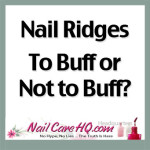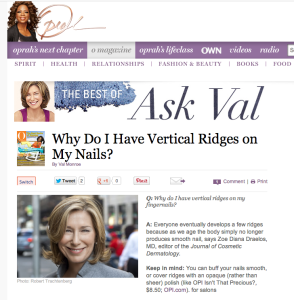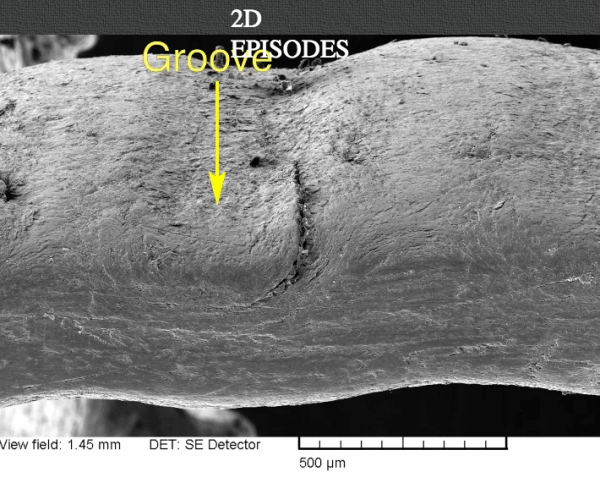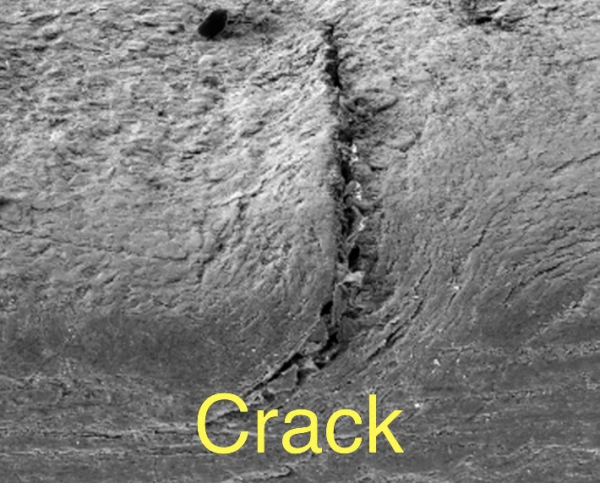Ridges in Nails—ASK ANA

ASK ANA
Hi Ana, I am starting to get deeper ridges on my nails and I don’t like the way it looks. Is it ok to buff them down so my nails are smooth? Some people say yes, some say don’t do it. I don’t know who to believe. ~Jessica
ANSWER
I’ve got ridges too and I don’t like them either.
And you know, it’s pretty tough to find the truth, especially when Oprah’s very own beauty director, Val Monroe, recommends incorrect advice. She endorses buffing your nails smooth or covering ridges with an opaque (solid) polish.” [source: Oprah.com]
Both of these are terrible ideas!
I’ll explain why.
The Truth About Ridges in Nails
I recently finished watching the 3D DVD "Inside Doug Schoon's Brain." Mr. Schoon's book, Nail Structure and Product Chemistry is my 'Nail Bible'. I can not tell you how exciting it was to me to finally find out "WHY" we should NOT file down ridges! *geeky girl glee.*
In this DVD, Mr. Schoon explains what's happening with ridges by using an electron microscope photo enlarged 150 times.
You know how I say almost everything we seem to know about nails is BACKWARDS? This is true for our belief about ridges too.
Ridges in nails are actually the healthy part of the nail. It's the concave portions that are thinner because the nail matrix isn't working properly and at full capacity.
It is actually the dips in the nails that are the weaker portions! The thicker portions (ridges) are really the healthier, stronger nail sections.
Take a look at the photo below. It is a cross-section of the nail plate enlarged 150 times. The wavy top is the visible top surface of your nail. The bottom is the part that sits on your nail bed. It is also the same part that becomes the underside of your nail tip as it grows past your fingertip.
The higher portion is what we consider a "ridge". The "groove" in between each ridge is typically 5% to 7% thinner than the rest of the healthy nail.
See that big crack to the right of the yellow arrow? We'll zoom in on that crack in the next photo.
Since the grooves are thinner, they have a higher tendency to crack, like the photo below. As this crack becomes worse, the layers will start to peel away, causing your nail plate to be even thinner. This can lead to those crazy splitting nails that are so hard to deal with.
The Aging Process
This explains why ridges seem to get more pronounced with age. As we age, our digestive system does not function at the level of a young person.
We don't absorb as many of the required vitamins and minerals for nail production. Therefore, the ridges appear more pronounced, when it's actually the thinner, grooved areas becoming more deeper and more pronounced.
Should You File Ridges in Nails?
You probably know the answer by now. If we file down the ridges to match the rest of the nail plate, we're actually thinning our nail plate to match the thinnest, weakest portions of the nail!
Ms. Monroe's Flawed Advice
Now I’ll get back to Ms. Monroe’s advice. Obviously buffing and sanding is a bad idea. But what about the opaque polish?
It’s my understanding and experience that nail polish seems to be formulated to create a thin, even coating over the entire nail. It is going to create a nice, thin layer over the ridges and the dips.
When I see older women with polish over their ridged nails, the polish seems to make the ridges more obvious. Opaque polish is not a great idea either.
The Solution
Along with Doug Schoon, my recommendation is to use a high quality ridge filling base coat to fill in the grooved areas and smooth out the surface of your nail before applying your color lacquer.
Rather than creating one thin layer like polish, ridge filling base coats are full of micro-particle ingredients that settle into the concave portions of your nail.
Using a ridge filling base coat will solve three problems for you.
- Reducing staining
- Creating a surface that polish loves. (Base coats are formulated to bond to the natural nail plate. Polish is formulated to bond to base coat, not the nail.)
- Smoothing the nail surface
What Do You Think?
 US Dollars
US Dollars
 CAD
CAD
 Euro
Euro





